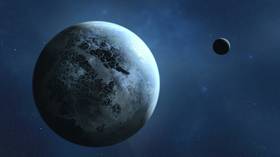‘Goldilocks’ & the lost world: New technique for tracking far-away planets could help in search for HABITABLE regions of universe

The rediscovery of a planet lost in outer space could signal the beginning of tracking a habitable world in the ‘Goldilocks zone’ of a far distant solar system.
The planet is one of hundreds of ‘lost’ planets discovered by astronomers from the University of Warwick, and was the result of a new way of tracking and logging planets in hopes of finding something similar to our own.
Some of these lost planets reside in the Goldilocks zone – a particular range of orbits that allow the existence of liquid on a planet’s surface: too close to the sun and it will be too hot, too far away, too cold.
To accomplish the research, the team adapted the usual transit method of tracking a planet, in which the telescope waits for a dip in light that indicates that there is an object passing between the telescope and a star. It then follows the planet’s trajectory for 27 days before it disappears.
Also on rt.com 11-billion-year hole in our understanding of the history of the universe now ‘filled’In this instance, however, the team followed the planet and further tracked it from a different station, allowing them to assess its speed and therefore orbit.
With this new pioneering technique, the researchers found they were able to track these planets – which would usually disappear from view and become ‘lost’ – for a longer period of 79 nights, granting an additional understanding of their orbits, and therefore of their temperature.
One of the ‘lost’ planets that was found, known as NGTS-11b, orbits a star 620 light-years away and the size and mass of Saturn, with an orbit of 35 days, making it much closer to its sun than we are.
Also on rt.com SpaceX Falcon 9 rocket launches satellite for S. Korean militaryAlthough 100 percent uninhabitable, it is thought to be much closer to “the Goldilocks zone than many previously discovered planets which typically have temperatures above 1,000°C [1,832°F],” said Dr. Samuel Gill from the department of physics at the university.
“Longer period planets are cooler, more like the planets in our own solar system. NGTS-11b has a temperature of only 160°C [320°F] — cooler than Mercury and Venus,” Gill added.
In any case, the findings open up a new world of potential planets that could potentially harbor extraterrestrial life, and are a landmark in how we will seek such planets out in the future.
If you like this story, share it with a friend!












